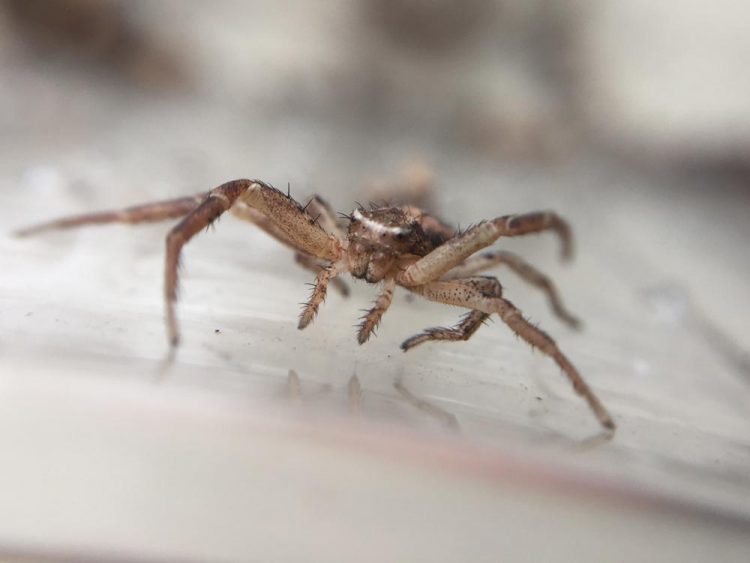Flying spider – Thekla's Wondrous Journey

Close-up of a crab spider © Moonsung Cho
Thekla opens her parachute, faces into the wind and is propelled away. Thekla is not some kind of extreme athlete though; she is a spider. Who would have thought that this little arachnid could “fly”? This phenomenon is nicely referred to as “ballooning”, as the wind shapes Thekla's delicate silk threads into a balloon and she takes off. South Korean Moonsung Cho is doing his doctorate at TU Berlin’s Institute of Biology. In his doctoral thesis, he examines which factors determine flight.
“Only a light wind is required to carry some species to heights of up to 4500 meters and for distances of several hundred kilometers.”
The spider's abdomen contains what are known as spinnerets with several hundred spigots. Each spigot ejects a silk thread no more than 320 nanometers thick. This process can scarcely be perceived by the human eye in real time. Perhaps this explains why this phenomenon is underexplored?
Moonsung Cho plans to change this. He is doing his doctorate at the Institute of Biology under Professor Dr. Peter Neubauer, head of the Chair of Bioprocess Engineering, and Professor emeritus Ingo Rechenberg. “Currently there are only a few studies which have researched the behavior of flying spiders,” he says. “The phenomenon is particularly common among young spiders. Some species suddenly fire threads into the air and only a light wind is required to carry them to heights of up to 4500 meters and for distances of several hundred kilometers.”
“In my doctoral thesis I am examining which factors determine flight.”
“Ballooning” plays an important role in the propagation of species of spiders. “In my doctoral thesis I am examining which factors determine flight. I am focusing particularly on gossamers.” It is pure coincidence that spiders came to play the leading role in his doctoral thesis. “I made a video of spiders when I was taking a stroll on the Fliegeberg (The Fliegeberg is a hill serving as a monument to Otto Lilienthal's early efforts at flight.) in the Berlin district of Lichterfelde and observed that the spiders not only flew different distances, but also actually prepared themselves for flight,” Moonsung Cho explains. “Directly before taking off, they stretched out one of their legs in order to test the wind speeds. I was fascinated by this at once.”
“Young spiders require only a couple of threads to get airborne, while larger spiders require between 50 and 60.”
This fascination is fully understandable given that flight behavior is Cho's area of expertise. Before coming to Berlin, 39-year-old Cho studied fluid mechanics. In order to examine the behavior of the flying spider, he placed 14 crab spiders on a small raised platform on the Fliegeberg and observed these passive aviators in their natural environment.
He then conducted the experiment in a laboratory, simulating different kinds of winds. One of the facts he discovered was that the spiders only take off when the wind speed is under three meters per second. He also observed that turbulent wind currents improved the spiders’ ability to float in the air. Of particular interest to note is that young spiders require only a couple of threads to get airborne, while larger spiders require between 50 and 60.
Cho still has some tests to conduct to complete his doctoral thesis. He is, however, already thinking about the possible wider application of his discoveries. “It may be possible to examine whether passive flying structures inspired by the phenomenon of thread gliding (Fadensegelflug) can be used to explore dangerous weather conditions such as tornadoes or clear-air turbulence. These are just considerations for now,” Moonsung Cho concludes.
Test pilot Thekla is doing well, by the way. She and the other spiders were released back into nature after the laboratory experiments were concluded.
Image and video downloads:
• The “flight” of the spiders on video: https://youtu.be/_Ow1-62opK0
• Photos: http://www.tu-berlin.de/?195903&L=1
For further information please contact:
Moonsung Cho
TU Berlin
Email: m.cho@campus.tu-berlin.de
Media Contact
All latest news from the category: Life Sciences and Chemistry
Articles and reports from the Life Sciences and chemistry area deal with applied and basic research into modern biology, chemistry and human medicine.
Valuable information can be found on a range of life sciences fields including bacteriology, biochemistry, bionics, bioinformatics, biophysics, biotechnology, genetics, geobotany, human biology, marine biology, microbiology, molecular biology, cellular biology, zoology, bioinorganic chemistry, microchemistry and environmental chemistry.
Newest articles

High-energy-density aqueous battery based on halogen multi-electron transfer
Traditional non-aqueous lithium-ion batteries have a high energy density, but their safety is compromised due to the flammable organic electrolytes they utilize. Aqueous batteries use water as the solvent for…

First-ever combined heart pump and pig kidney transplant
…gives new hope to patient with terminal illness. Surgeons at NYU Langone Health performed the first-ever combined mechanical heart pump and gene-edited pig kidney transplant surgery in a 54-year-old woman…

Biophysics: Testing how well biomarkers work
LMU researchers have developed a method to determine how reliably target proteins can be labeled using super-resolution fluorescence microscopy. Modern microscopy techniques make it possible to examine the inner workings…





















